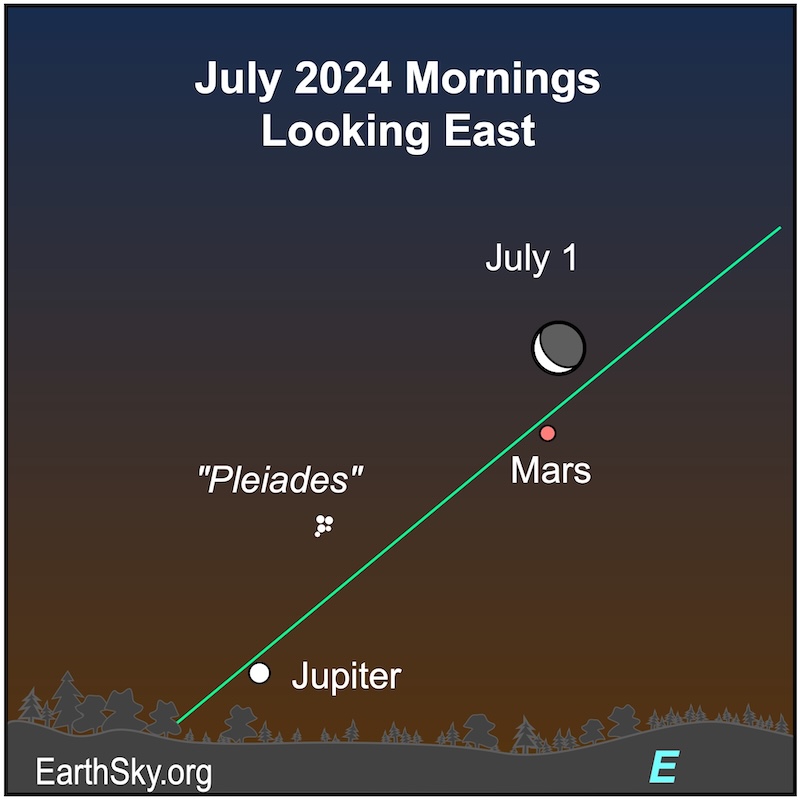
As July opens
As July 2024 opens, Jupiter and Mars are near the waning crescent moon, and near each other, in the east before sunup. See the chart above. And – if you watch in the coming weeks – you’ll get to see Mars sideswipe Jupiter in a conjunction that’ll culminate on August 14. Start watching the two neighboring planets now (Mars is the 4th planet from the sun, and Jupiter the 5th). By mid-July, Mars will cross a constellation boundary into Taurus the Bull, where Jupiter is currently hanging out. There are many splendid things to see in Taurus. This conjunction will be fun!
The two are not far from the misty Pleiades star cluster.
A bonus planetary conjunction will happen on July 15, when Mars will be about half a degree from Uranus. Uranus is theoretically visible to the eye, but only in a dark sky and only then if your eyesight is perfect. So, around July, use binoculars to zero in on reddish Mars, then spot Uranus right beside it. Mars is red. And Uranus will be much fainter, and bluish-green in color.
Read: Why is Mars sometimes bright and sometimes faint?
After mid-July
Afterwards, Mars will pull away from Uranus. You’ll see it get a bit closer to the Pleiades, as it makes a beeline toward Jupiter. Just to make it even more interesting, the waning crescent moon enters the scene again on July 30.
On that date, bright Jupiter, red Mars, the bright star Aldebaran, the pretty Pleiades and the V-shaped Hyades star cluster will create quite a scene. They’ll all be in the eastern sky two hours before sunrise.
Then, the next morning, the moon – as an even thinner crescent – hangs a bit farther northeast of the celestial grouping.
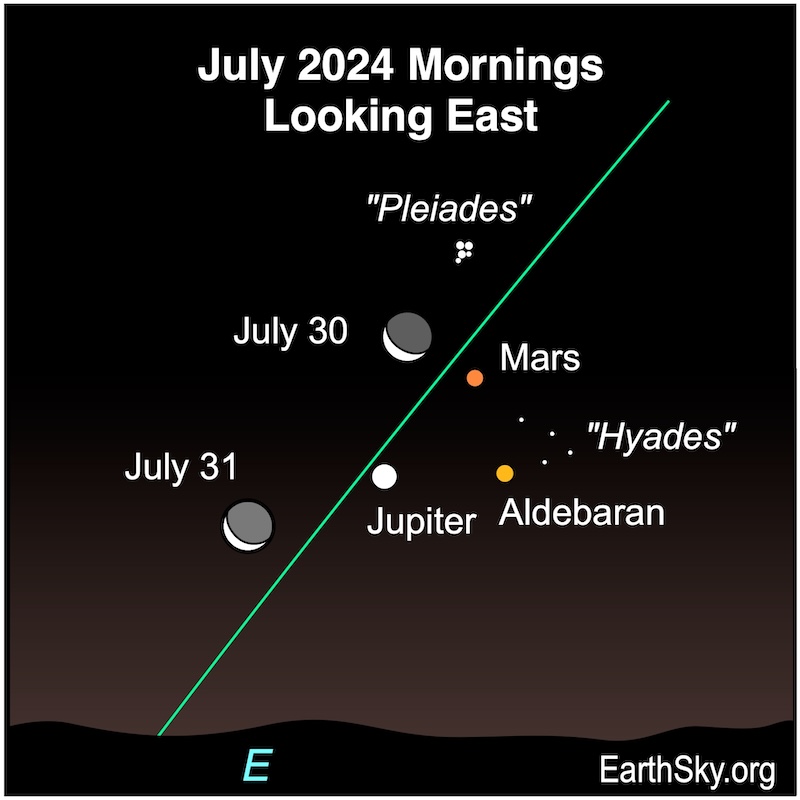
The big event: Jupiter and Mars conjunction August 14
The closest pairing of this planetary duo will come on the morning of August 14. That’s when bright gas giant Jupiter will get a visit from rocky red Mars on our sky’s dome. Then, the little planet will appear less than the width of a full moon from Jupiter. They’ll look close on our sky’s dome. In reality, the two will remain more than 300 million miles (500 million km) apart, even though they are next-door neighbors in our solar system.
Using just the unaided eye, the bright white light of Jupiter will contrast nicely with the dimmer and distinctly redder shine of Mars. In binoculars, Jupiter’s moons will enhance your enjoyment of the view. And this conjunction will be a great event for telescope owners and astrophotographers. You’ll be able to capture both planets in one view and thoroughly examine these remarkably different worlds. If you catch a great pic, please submit it to EarthSky’s community page!
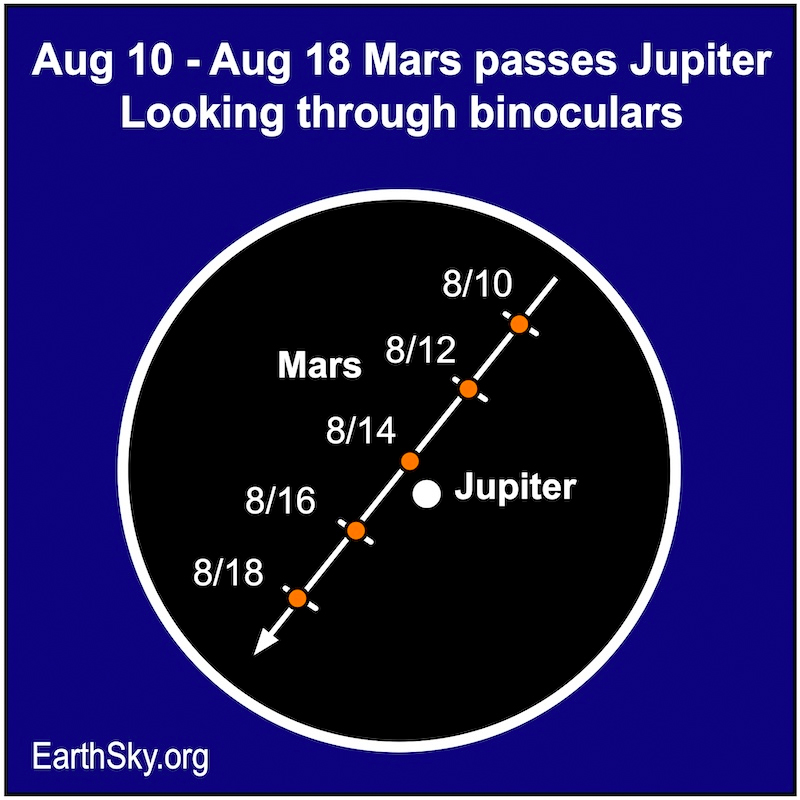
For a precise view from your location, visit Stellarium.
Charts from Guy Ottewell
The following charts all come from U.K. astronomer Guy Ottewell. You’ll find charts like these for 2024 in his Astronomical Calendar.
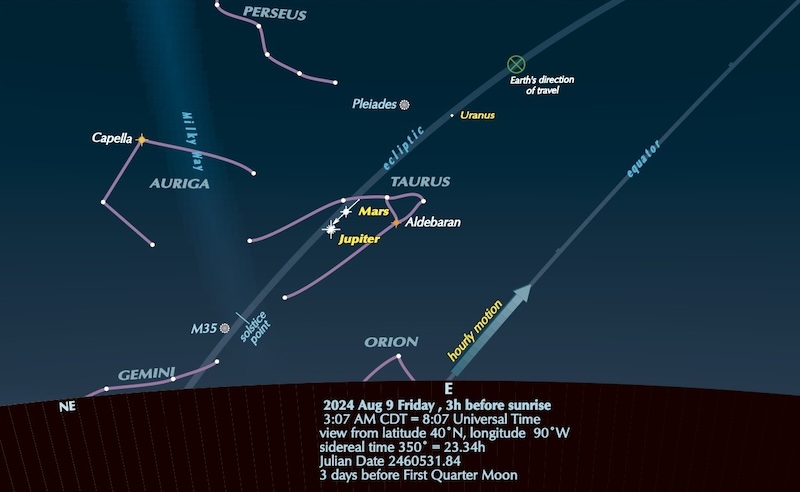
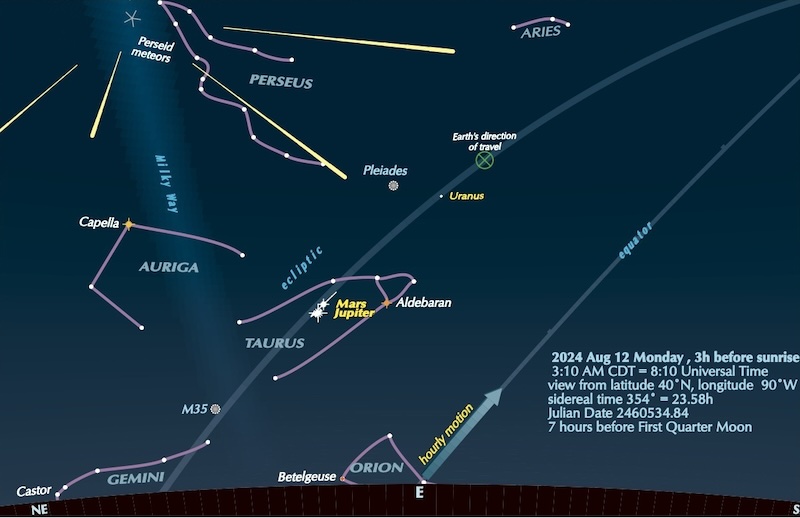
Heliocentric solar system view of the planets in July and August 2024
Here’s a heliocentric view of the solar system from above for July and August when Mars and Jupiter will appear close together in the morning sky.
Guy Ottewell explains heliocentric charts.
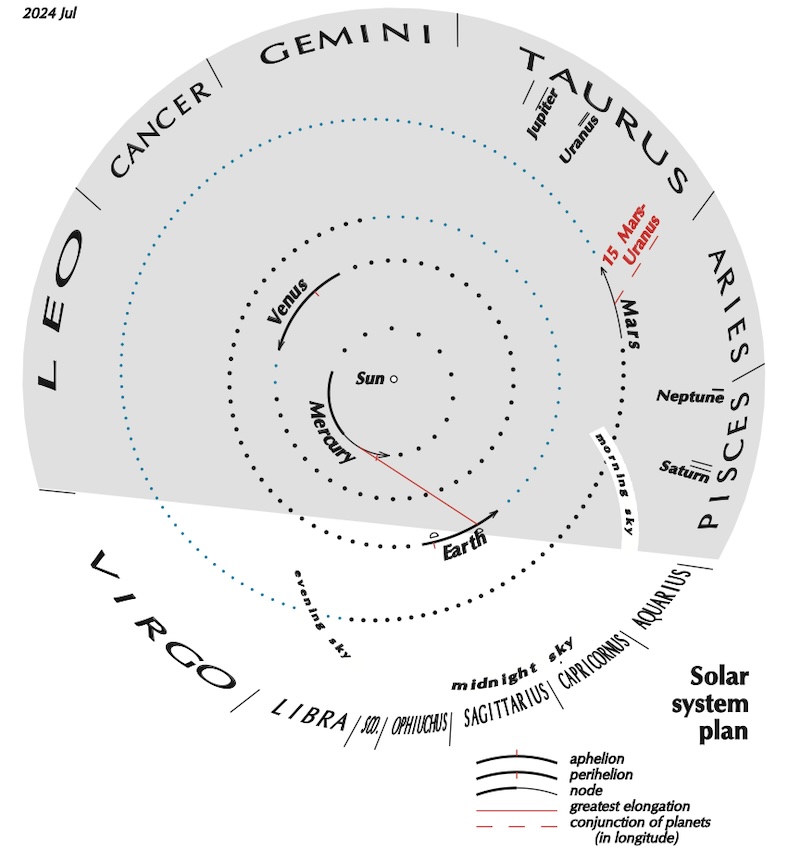

Bottom line: Start watching on July mornings for the upcoming Jupiter and Mars conjunction. The neighboring planets will get closer and closer – against the backdrop of the constellation Taurus the Bull – culminating on August 14, 2024.
The post Coming soon! Jupiter and Mars conjunction before dawn first appeared on EarthSky.
from EarthSky https://ift.tt/D4RK7YG

As July opens
As July 2024 opens, Jupiter and Mars are near the waning crescent moon, and near each other, in the east before sunup. See the chart above. And – if you watch in the coming weeks – you’ll get to see Mars sideswipe Jupiter in a conjunction that’ll culminate on August 14. Start watching the two neighboring planets now (Mars is the 4th planet from the sun, and Jupiter the 5th). By mid-July, Mars will cross a constellation boundary into Taurus the Bull, where Jupiter is currently hanging out. There are many splendid things to see in Taurus. This conjunction will be fun!
The two are not far from the misty Pleiades star cluster.
A bonus planetary conjunction will happen on July 15, when Mars will be about half a degree from Uranus. Uranus is theoretically visible to the eye, but only in a dark sky and only then if your eyesight is perfect. So, around July, use binoculars to zero in on reddish Mars, then spot Uranus right beside it. Mars is red. And Uranus will be much fainter, and bluish-green in color.
Read: Why is Mars sometimes bright and sometimes faint?
After mid-July
Afterwards, Mars will pull away from Uranus. You’ll see it get a bit closer to the Pleiades, as it makes a beeline toward Jupiter. Just to make it even more interesting, the waning crescent moon enters the scene again on July 30.
On that date, bright Jupiter, red Mars, the bright star Aldebaran, the pretty Pleiades and the V-shaped Hyades star cluster will create quite a scene. They’ll all be in the eastern sky two hours before sunrise.
Then, the next morning, the moon – as an even thinner crescent – hangs a bit farther northeast of the celestial grouping.

The big event: Jupiter and Mars conjunction August 14
The closest pairing of this planetary duo will come on the morning of August 14. That’s when bright gas giant Jupiter will get a visit from rocky red Mars on our sky’s dome. Then, the little planet will appear less than the width of a full moon from Jupiter. They’ll look close on our sky’s dome. In reality, the two will remain more than 300 million miles (500 million km) apart, even though they are next-door neighbors in our solar system.
Using just the unaided eye, the bright white light of Jupiter will contrast nicely with the dimmer and distinctly redder shine of Mars. In binoculars, Jupiter’s moons will enhance your enjoyment of the view. And this conjunction will be a great event for telescope owners and astrophotographers. You’ll be able to capture both planets in one view and thoroughly examine these remarkably different worlds. If you catch a great pic, please submit it to EarthSky’s community page!

For a precise view from your location, visit Stellarium.
Charts from Guy Ottewell
The following charts all come from U.K. astronomer Guy Ottewell. You’ll find charts like these for 2024 in his Astronomical Calendar.


Heliocentric solar system view of the planets in July and August 2024
Here’s a heliocentric view of the solar system from above for July and August when Mars and Jupiter will appear close together in the morning sky.
Guy Ottewell explains heliocentric charts.


Bottom line: Start watching on July mornings for the upcoming Jupiter and Mars conjunction. The neighboring planets will get closer and closer – against the backdrop of the constellation Taurus the Bull – culminating on August 14, 2024.
The post Coming soon! Jupiter and Mars conjunction before dawn first appeared on EarthSky.
from EarthSky https://ift.tt/D4RK7YG

Aucun commentaire:
Enregistrer un commentaire